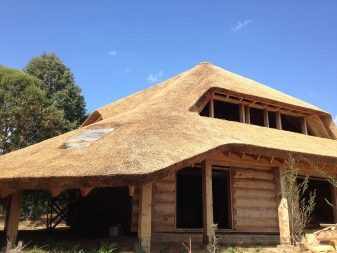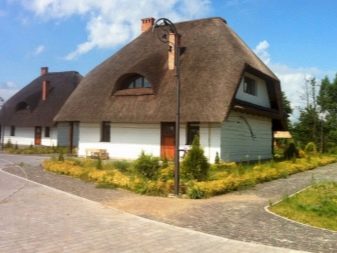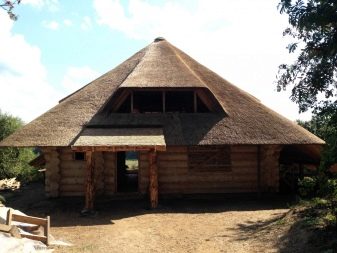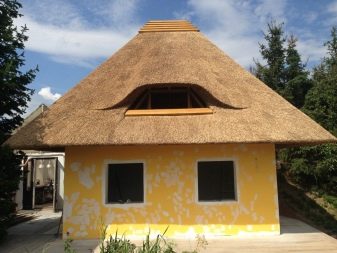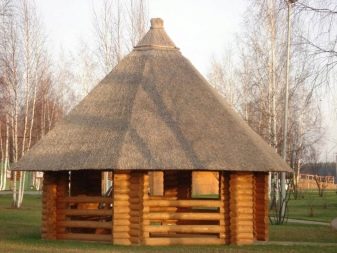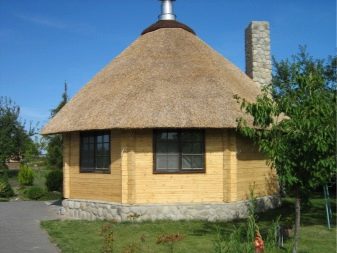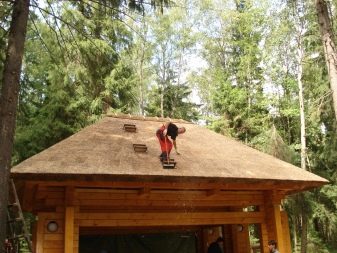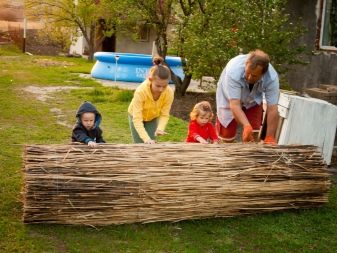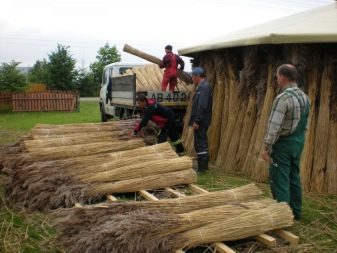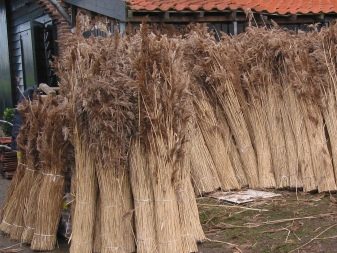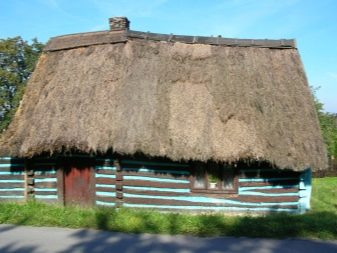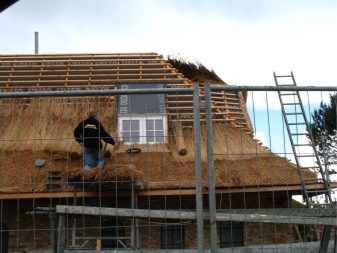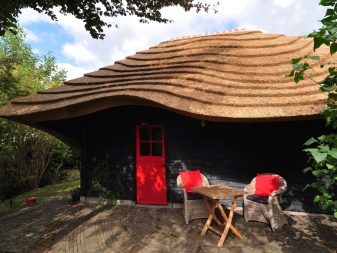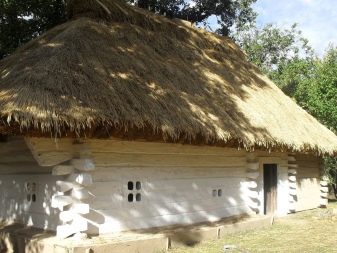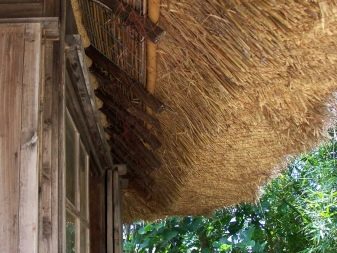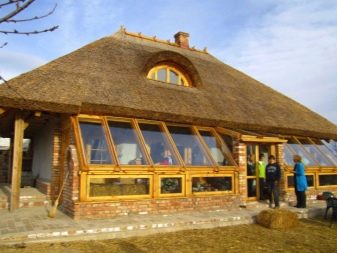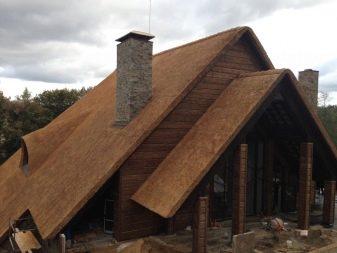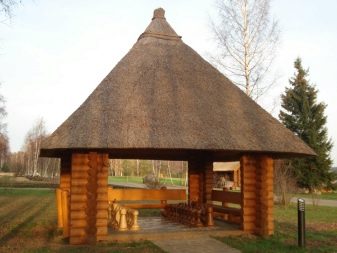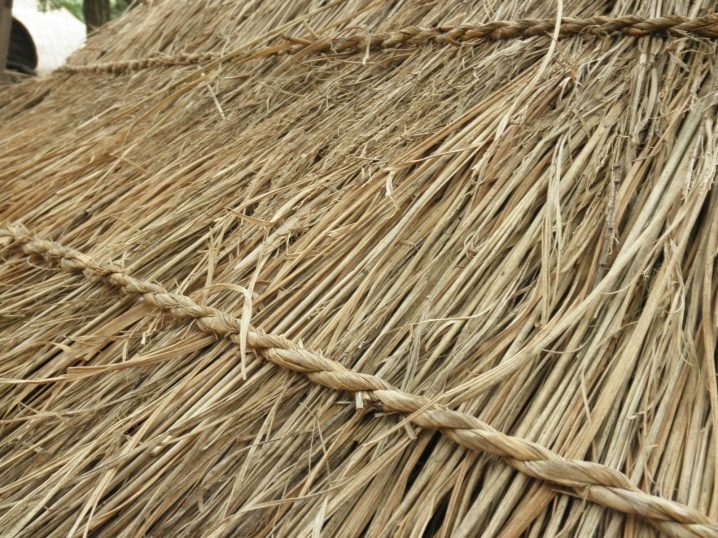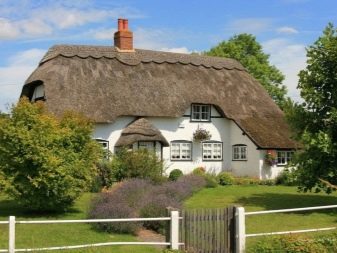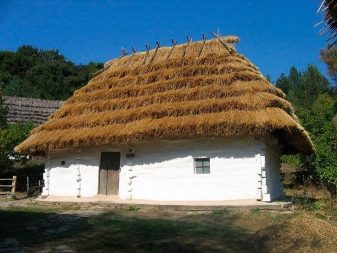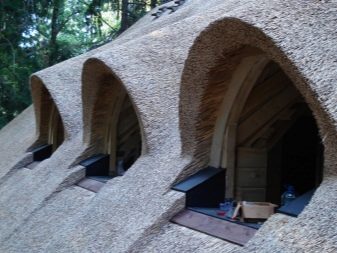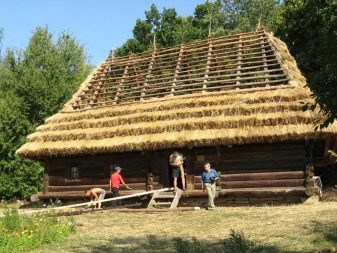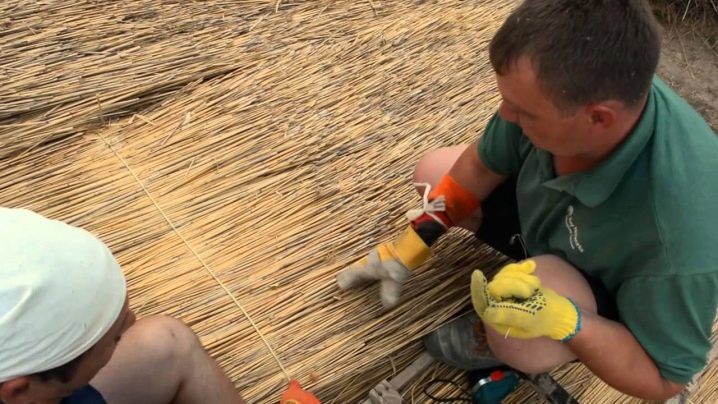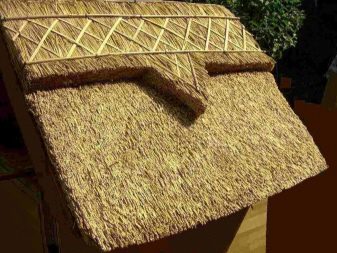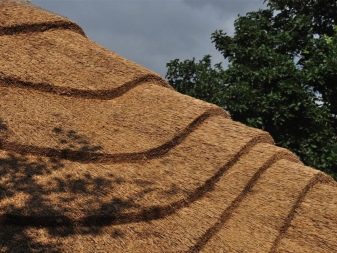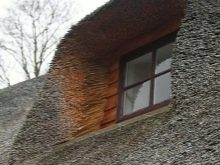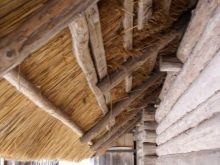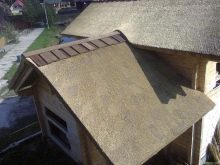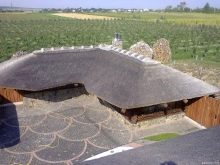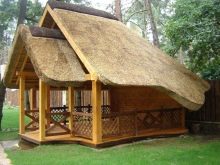Reed roof: an original and practical solution
Perhaps, many people remember from the movies or they themselves met houses covered with reeds in the villages. Such coverage was important for a long time and was used to cover the roofs in the houses of the poor. With the advent of more modern materials, reeds have completely ceased to be used. Now more often use tiles, slate, ondulin and other modern options. But some of them in the process of exploitation can release harmful substances. Supporters of a healthy lifestyle found a way out of this situation and switched to using reed for covering roofs - this unfairly forgotten material.
Special features
Today, more modern materials are chosen for laying roofs. Using them, you can complete the work much faster, it is a less labor-intensive process than with reed laying.Few people think that modern materials are less environmentally friendly than natural materials, that such insulation during operation can release substances harmful to human health. In addition, on hot summer days, such an overlap will not save from the heat, and in winter it will let the cold through. Reed is a natural environmental material, when used to cover the roof in a room at any time of the year, an optimal and comfortable temperature will be maintained.
In recent years, interest in environmentally friendly coating has increased significantly. The first to cover the reeds began to apply the owners of entertainment, cafes and hotels. They used natural material to decorate buildings in an original style to attract customers. And it really was the right decision - buildings with a roof made of reeds immediately began to stand out against the background of monotonous buildings.
Owners of private houses began to wonder how comfortable and safe modern materials are. Many have concluded that it is time to return to the use of environmentally friendly materials for construction.
Judging by the increased demand, reed is increasingly used for work.
It has every reason to be, because this natural material has many positive properties.
- The coating has high thermal insulation properties. In winter, the heat will not go away through the layers of reed, and in the summer it will be cool in the room.
- Reed grows on soils with high humidity, so it is less susceptible to water. The material will not rot or tread, it is rare to see a fungus, mold or moss.
- Ocheret has resistance to strong winds, temperature drops and other adverse factors.
- Natural material will contribute to the creation of natural ventilation for the attic room, which can serve as a reason for refusing to insulate the building.
- The reed has a tubular structure, a layer of such material will provide high sound absorption. If drops of heavy rain or other sounds hit the roof, it will absorb noise.
- The reed coating will not accumulate static electricity, which will prevent lightning from entering during a thunderstorm.
- When covering surfaces, it is possible not to repair the roof for a long time, its service life is at least 60 years.
Sometimes there is a need to fix small defects on the roof.It is very simple to fix them; for this, a patch is made at the necessary site and new reeds are fixed. After such a repair, patches will be immediately visible, but after a few months the difference will disappear.
Reed roof with time will not dim, with the color of it will become deeper and noble. Such a roof will perfectly fit into a certain style, it will harmoniously look at the background of the environment. The plant has flexible stems that allows you to use them to create complex architectural structures.
It should be noted that the reed coating has a major drawback, according to which many do not risk using it. The disadvantage of the reed coating is its flammability. It should be clarified here that if you perform the correct installation in compliance with the fire safety rules, you can not worry about this, the ignition of the roof is practically excluded.
To provide protection against fire, the coating is treated with special impregnations. The flame retardants will eventually leach out with rain, so every 3-5 years should be impregnated surface.By the way, in many European countries the treatment with fire retardants is not carried out in order to preserve absolute naturalness and environmental friendliness.
A small harm to such coatings can bring the birds, who are beginning to pull the twigs out of the coating in order to make their nest with them. This can be avoided, there is a stack of reeds tightly. In this case, individual reeds will not protrude from the general layer and will not be accessible to birds.
If the reed is used to cover the roof, it should be noted that the purchase of such material, its installation and installation can be costly. To reduce the cost of repairs, you can procure the material yourself.
Selection and procurement of material
When choosing a reed for roofing, you should find out how suitable this material is for a particular dwelling, how to harvest, store and use it.
Reed thickets can be found at reservoirs, in coastal zones of the rivers, marshes. Usually, reeds are harvested in winter when the reservoir is covered with ice. Cut off the reed sharpened shovel, sickle or motokosa.
Preparing the required amount of material is not as easy as it may seem.To reed enough for the entire roof, it is necessary to cut a very large number. It is not always possible to carry out such work alone; one must be prepared for long and difficult work. When harvesting material, reed should be selected for its appearance; it should be of a light color, with no traces of mold. The vine should not break or crumble.
When the reed is cut, it is folded into sheaves, which are usually 60 cm wide in girth. This size is convenient for work, these bales are easy to carry, easy to work with. For linking take the twine, wire, often use the twisted stalks of reeds. The sheaves are tied in two places - the first bundle is tied down from the bottom, and the second is half a meter from the bottom string.
On the top of the stems are inflorescences, which are usually cut immediately in the process of harvesting. Sometimes these panicles are not cut, as there are technologies by which stacking is done with them. To tie sheaves and trim panicles, goats are often used. Such a simple device can greatly facilitate the procurement process. After collecting the reeds in bales they are left to dry. Sometimes the collected reed is left before the onset of heat, at which time it is pruned and cleaned.
According to the masters, who have more than once been engaged in laying roofs from reeds, for a medium-sized house, 10 sheaves of standard size should be taken, that is, with a girth of 60 cm. This amount is enough to cover the entire roof. These calculations are based on a 20% stock of material. If it was not possible to prepare the sheaves on its own, it is possible to purchase eurobags, which sell both individually and already tied up in bales.
Characteristics of raw materials
Reed grows predominantly on the banks of rivers or on the edge of marshes. The plant has a long hard stem and narrow sheets. They use rogoz to cover the roofs, to decorate, they also use it for wall insulation.
Natural material has certain characteristics.
- Resistance to any weather conditions. The reed roof helps to preserve heat in the winter and to create coolness in the summer, as well as protect it from rain, wind and hail.
- Flexibility of the material. The stems of the plant are very flexible and do not break, they are often used in the construction of complex structures.
- Low weight. The reed has a very small weight, inside the stem is hollow, due to its lightness, the frame of the roof does not become heavier.
- High resistance to rot and mildew.
- Durability. If the laying technology is observed, the reed roof will last a long time.
When using natural material, it is possible to make an original construction out of a conventional construction; they will immediately pay attention to such a house. It will noticeably stand out among the bulk of monotonous structures.
Laying specifics
Perform work on laying reeds on the roof is better in the warm season. For work choose dry and windless day. Before starting work, they check whether the material is suitable for work, and if the sheaves are a little dry, they are pre-moistened with water.
Natural material for the roof, you can take freshly prepared. When constructing a roof from cattail, it is taken into account that such work has certain features. Reed placed on the roof at an angle of at least 35 degrees, so you can avoid the accumulation of water on the surface. Excessive moisture can cause mold. A drainage layer is installed around the perimeter of the roof so that rainwater does not erode the blind area.
It should not be used to cover the roof reed, if above it will be located high spreading trees.The leaves will block the roof from the sun, and therefore the surface will not dry out, as a result of which it may rot.
Required tools
The performance of any work is greatly simplified if special tools and devices are used. Work is carried out on the roof, which suggests that there should be comfortable devices to facilitate the work.
Normal employee recruitment:
- comb or brush with a short or long handle;
- knife with serrated blades;
- sickle with sharpening;
- robust work gloves;
- spatula.
These tools are essential when working. Combs have a different design. For the manufacture of comb used wood. Nails with cut-off caps are driven in at the end of the tool, this part of the comb is used for combing out the stems. It is not always convenient to use the comb to do the nailing; for this purpose a heavy scapula is used.
Usually masters use metal tools in their work. It is used for simultaneous compaction, leveling and combing the bristle coating. After such treatment from the side, the coating appears velvety.
In addition, the masters can not do without a screwdriver, which is necessary for screwing screws. Often used in the work and a hammer. It is necessary to prepare a device for raising sheaves on the roof, this can greatly facilitate the work. For convenience, take special little ladders or steps, work with them on surfaces already covered with reed.
Technology
If a reed was chosen for installation, then after its preparation, the installation of a batten is started. The slats are made of timber 40 by 60 or 50 by 50 mm, they are laid in 30 cm increments. When mounting, it should be taken into account that there will be one or several people on the roof, so it must be strong and withstand considerable weight.
Put reed in a certain way:
- To hold the sheaves in the crate hammer nails or tighten screws.
- Spread reed from the lower tier. The first tier can be laid out using a stepladder, woods or high stairs.
- For further advancement up the roof, you can use small ladders that are attached to the crate. When using one or two ladders, you can quickly move from one place to another.
- Sheaves tightly stack to each other and fixed with wire. When laying snopik try to make them very tightly located next to each other.
- When all the sheaves are laid, go to the installation of the ridge, for this it is better to take smaller stems. After laying, they should be pressed with a ridge profile.
- When all the sheaves are laid, they are knocked down and leveled.
Put the reed on the roof in different ways:
- installation, which is carried out under the brush;
- installation parks;
- in natrusku;
- panels.
Most often when installing natural material choose the installation under the brush. In the process, sheaves of reeds spread in dense rows. They are put on the surface of the slopes with their roots down. After laying the roots are chopped off.
Before work should be carried out training. The ground near the house is covered with a linen cloth or a film so that all the garbage will fall directly on them. This will eliminate the need to spend extra time on cleaning up a large amount of garbage, which remains after the roof is “combed out”.
When mounting under the brush, the work is carried out in rows, until they reach the ridge. After installing it, you should check how smoothly it was set.If the work with the ridge was carried out correctly, the final stage of consolidation of sheaves and combing of the surface follows.
After laying the clapping movements begin to seal the surface, and then combed out, getting rid of excess stems. For such work, take a special comb or brush and spatula. If all the technology of laying and leveling was observed, the roof, which was covered under the brush, will look monolithic and resemble a velvet coating. Once again it is worth recalling that the material is flammable, so the surface is impregnated with special means. By the way, it is better to process the already finished roof, rather than individual sheaves.
If another method is chosen - “parks”, then when using it, the reeds are placed root down only in the first rows, then bales should be laid with roots up.
If you choose the option "natrusku", then carry out the work is even easier, but using this method, the roof does not always look aesthetically pleasing. When choosing this option, the reed is simply thrown on the roof in a chaotic manner and fixed from above with the help of rails, bars or poles.This technology is rarely used, although there may be fans of this option.
The panels are used in roofing, surface finishing, used for decorative purposes. To make them, take prepared dried and cut sheaves. A bale can be made in any size depending on the thickness chosen for the coating. If for the roofing of houses they take a panel with a thickness of 30-35 cm, then for arbors you can choose a shield much smaller in width. It is enough to choose panels with a width of 15-20 cm.
Tips and tricks
Making a roof out of reeds is not an easy task, and it is not always the beginner’s power to do such work. It is better to entrust the roofing work to already experienced craftsmen, who more than once were engaged in laying reeds in practice. In order for the roof to serve for many years and to have high operational properties, it is necessary to strictly follow the installation technology.
If you want to do the work with your own hands, you can try your hand at a small area using a template. To do this, you need to make a frame in the form of crates or take a plywood sheet and install this base at a certain angle.Then you can try to stack and secure sheaves in one of the selected ways. After in the process of working it turned out to fit three rows correctly, you can proceed to leveling and combing the material.
If the work is carried out independently, without experience in the industry, you can try to build a roof of reeds on less visible buildings, for example, you can cover the garden gazebo to “tamper” your hands.
If the work is carried out independently, special attention should be paid to the correct placement of the sheaves, since the material has low fire resistance. Therefore, the roof is treated with special chemical solutions. In order not to allow air to circulate freely, the reeds should be laid very tightly. If installed correctly, the roof will not light up.
When choosing a material, you should consider that there are more than 300 types of reeds, but for the roof they use only 5 of them, which grow on the banks of freshwater bodies. Plants that grow near estuaries will not be so strong and durable and have the same characteristics as plants grown near fresh water.
About what roofs from a cane happen, look in the following video.





